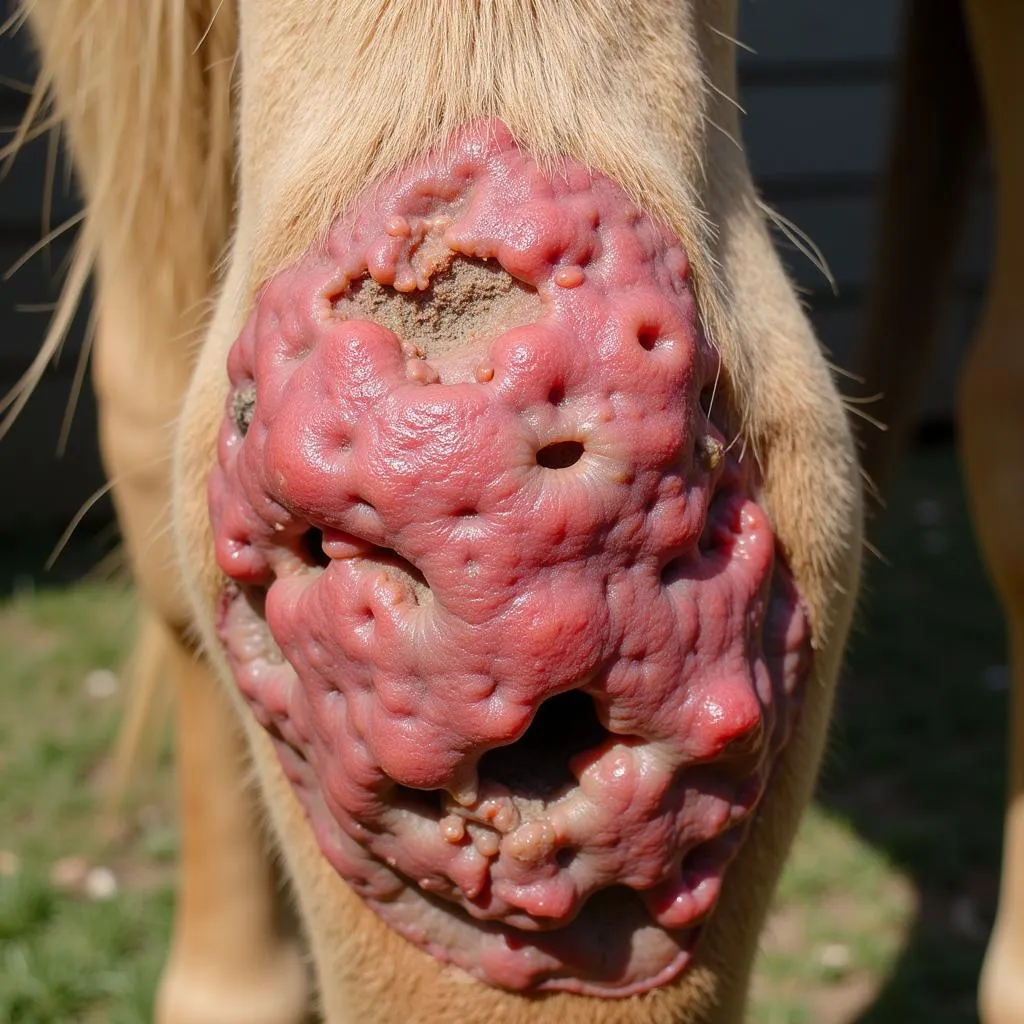Scratches, also known as dermatophilosis, is a common skin infection in horses that can be caused by a variety of factors. This bacterial infection can lead to skin lesions and sores that are itchy, painful, and unsightly. If you’ve noticed your horse scratching excessively, it’s crucial to understand the cause and learn how to prevent it. This article will equip you with the necessary knowledge to manage this issue and keep your equine friend happy and healthy.
What are Scratches?
Scratches is a skin infection caused by the bacteria Dermatophilus congolensis. This bacteria thrives in moist environments, making it common in areas like the lower legs, fetlocks, and pasterns, where mud, sweat, and water can accumulate. Scratches are also more prevalent in humid climates and during periods of heavy rainfall.
Recognizing the Signs of Scratches
The telltale signs of scratches are:
- Excessive scratching: Your horse may constantly rub their legs against the stall walls, fence posts, or other surfaces.
- Red, inflamed skin: The affected areas will appear red, swollen, and irritated.
- Scabs and crusts: Lesions will form scabs and crusts, sometimes with a sticky discharge.
- Hair loss: Hair may fall out in patches around the lesions.
- Pain and lameness: In severe cases, your horse may experience pain and lameness.
Causes of Scratches
While Dermatophilus congolensis is the primary culprit, various factors can contribute to the development of scratches:
- Moisture: Wet conditions create a breeding ground for bacteria.
- Poor hygiene: Neglecting to clean your horse’s legs regularly can encourage bacteria growth.
- Overcrowding: Limited space and increased contact with other horses can facilitate the spread of infection.
- Trauma: Cuts, abrasions, or other wounds provide entry points for bacteria.
- Allergies: Some horses may have allergies that make them more susceptible to skin infections.
- Nutritional deficiencies: Lack of essential vitamins and minerals can weaken the immune system.
Preventing Scratches
Preventing scratches is far more effective than treating them. Here are some preventive measures:
- Maintain good hygiene: Clean your horse’s legs regularly with a mild antibacterial wash.
- Keep stalls and paddocks dry: Ensure proper drainage and ventilation to minimize moisture.
- Avoid overcrowding: Provide ample space for your horses to prevent excessive contact.
- Protect your horse from injury: Take precautions to prevent cuts, abrasions, and other wounds.
- Monitor your horse’s health: Regular checkups and a balanced diet can help maintain a strong immune system.
Treating Scratches
Treatment for scratches typically involves a combination of strategies:
- Cleaning: Clean the affected areas with an antibacterial wash.
- Antibiotics: Your veterinarian may prescribe oral or topical antibiotics to fight the infection.
- Topical medications: Anti-inflammatory creams and ointments can reduce inflammation and itchiness.
- Clipping: Clipping the hair around the lesions allows for better access to the affected areas.
- Bandaging: Bandaging can help protect the lesions and prevent further irritation.
Expert Insights
“Scratches can be a real pain for horses and owners alike,” says Dr. Emily Carter, a veterinarian with over 15 years of experience in equine medicine. “Early detection and prompt treatment are key to preventing complications and ensuring a quick recovery.”
“Preventing scratches should be a top priority,” adds John Lawson, a renowned horse trainer and owner. “Maintaining good hygiene and providing a clean and dry environment for your horse can go a long way in preventing this common infection.”
FAQ
Q: How long does it take for scratches to heal?
A: The healing time for scratches can vary depending on the severity of the infection and the chosen treatment. With appropriate care, most cases can improve within a few weeks.
Q: Are scratches contagious to other horses?
A: Yes, scratches can be contagious to other horses. It’s important to isolate infected horses to prevent the spread of the infection.
Q: Can humans get scratches?
A: While rare, humans can get scratches from contact with infected horses. Good hygiene practices, such as washing hands after handling horses, can help minimize the risk.
Q: What are the long-term effects of scratches?
A: In most cases, scratches will heal completely with proper treatment. However, if left untreated, the infection can become chronic and lead to permanent skin damage.
Q: How can I tell if my horse’s scratches are getting worse?
A: Signs that scratches are worsening include increased inflammation, worsening lesions, and the development of new lesions. If you notice these signs, consult your veterinarian immediately.
Conclusion
Scratches is a common skin infection in horses that can be effectively managed with proper care. By understanding the causes, recognizing the signs, and implementing preventive measures, you can help keep your horse healthy and scratch-free. If you suspect your horse has scratches, consult your veterinarian promptly for a diagnosis and treatment plan.
 Scratches on a horse's leg
Scratches on a horse's leg
 Treating scratches with a topical medication
Treating scratches with a topical medication
Remember, taking preventative measures and maintaining good hygiene can go a long way in keeping your horse healthy and free from scratches. If you need further assistance or have any questions, please don’t hesitate to contact us.